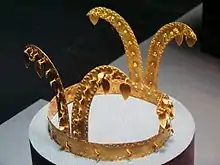Geumgwan Gaya
Geumgwan Gaya (43 - 532), also known as Bon-Gaya (본가야, 本伽倻, "original Gaya") or Garakguk (가락국, "Garak State"), was the ruling city-state of the Gaya confederacy during the Three Kingdoms Period in Korea. It is believed to have been located around the modern-day city of Gimhae, Southern Gyeongsang province, near the mouth of the Nakdong River. Due to its geographic location, this kingdom played a dominant role in the regional affairs from the Byeonhan period onward to the end of the Gaya confederacy.
| Geumgwan Gaya | |
| Hangul | 금관가야 |
|---|---|
| Hanja | 金官伽倻 |
| Revised Romanization | Geumgwan Gaya |
| McCune–Reischauer | Kŭmgwan Kaya |
Part of a series on the |
||||||||
|---|---|---|---|---|---|---|---|---|
| History of Korea | ||||||||
 | ||||||||
| Prehistoric period | ||||||||
| Ancient period | ||||||||
|
||||||||
| Proto–Three Kingdoms period | ||||||||
| Three Kingdoms period | ||||||||
|
||||||||
| Northern and Southern States period | ||||||||
|
||||||||
| Later Three Kingdoms period | ||||||||
|
||||||||
| Dynastic period | ||||||||
|
||||||||
| Colonial period | ||||||||
|
||||||||
| Modern period | ||||||||
|
||||||||
| Topics | ||||||||
| Timeline | ||||||||
Rise of the kingdom
Gaya confederacy (42–532 CE), founded by the King Suro, originated from the Byeonhan (also called Pyonhan, Byeon and Byeonjin) tribe, and it had 12 statelets. Byeonhan was one of the 3 Samhan, other 2 being Jinhan and Mahan.[1][2][3] According to the Samguk Yusa, Geumgwan Kaya was made of 9 villages united by King Suro of Gaya. His wife and queen Heo Hwang-ok, whom he married in 48 AD, is believed to be from an Ayuta kingdom.[4] As a confederacy of city states, Gaya rose to prosperity due to sea port trade with Japan and other states as well with land trade with China in the north.[1] Daegaya was an important city state and sea port as part of the Gaya Confideracy, it is associated with the place the Queen Heo had first arrived in Korea from her foreign location.
During this early time in the history of Gaya, several waves of migration from the north, including the earlier-extant Gojoseon, Buyeo, and the Goguryeo, arrived and integrated with existing populations and stimulated cultural and political developments. A sharp break in burial styles is found in archaeological sites dated near the late 3rd century AD, when these migrations are to have taken place. Burial forms associated with North Asian nomadic peoples, such as the burial of horses with the dead, suddenly replace earlier forms in the tombs of the elite. In addition, evidence exists indicating that earlier burials were systematically destroyed. In the early 1990s, a royal tomb complex was unearthed in Daeseong-dong, Gimhae, attributed to Geumgwan Gaya but apparently used since Byeonhan times.[5]
Religion
Centuries after Buddhism originated in India, the Mahayana Buddhism arrived in China through the Silk Route in 1st century CE via Tibet, then to Korea peninsula in 3rd century during the Three Kingdoms Period from where it transmitted to Japan. In Korea, it was adopted by the state religion by 3 constituent polities of the Three Kingdoms Period, first by the Goguryeo ruling tribe of Geumgwan Gaya in 372 CE, by the Silla in 528 CE, and by the Baekje in 552 CE.[1]
List of kings
In chronological order:[1]
- Geumgwan Gaya (lit. Gaya Confederacy) or Bon Gaya (lit. Original Gaya) era
- King Suro
- King Geodeung
- King Mapum
- King Geojilmi
- King Isipum
- King Jwaji
- King Chwhui
- King Jilji
- King Gyeomji
- King Guhyeoung (521-532 CE)
Dae Gaya (lit. Great Gaya) era
- King Ijinasi
- King Geumnim
- King Haji
- King Gasil
- King Inoe
- King Doseolji (?-562 CE)
- King
Decline
Geumgwan Gaya declined due to the wars with Japan and those tribes in north. Its various constituent city statelets fell one by one to Silla.[1] After Geumgwan Gaya capitulated to Silla in 532 AD, its royal house was accepted into the Sillan aristocracy[6][7] (probably because by that time, a major house of Silla, of the Gyeongju Kim clan, was related to the Gaya royal house, which was Gimhae Kim clan) and given the rank of "true bone," the second-highest level of the Silla bone rank system. General Kim Yu-shin of Silla (also of the Gimhae Kim clan) was a descendant of the last king of Gaya.
Gallery
 Gaya horse armour
Gaya horse armour Gaya armour
Gaya armour Gaya crown
Gaya crown Gaya pottery
Gaya pottery
See also
- History of Korea
- List of Korean monarchs
- List of Korea-related topics
- Daegaya
References
- Lee Injae, Owen Miller, Park Jinhoon, Yi Hyun-Hae, 2014, Korean History in Maps, Cambridge University Press, pp. 44-49, 52-60.
- Huiyi, Yi; Songsu, Park; Naehyon, Yun (2005). New history of Korea. Seoul: Jimundang. p. 136. ISBN 8988095855.
- Ebrey, Patricia; Walthall, Anne (2013-01-01). Pre-Modern East Asia: A Cultural, Social, and Political History, Volume I: To 1800. Cengage Learning. p. 101. ISBN 978-1133606512.
- "The Relations Between Korea and India: Korean-Indian Relations in Ancient History." http://www.korea.net/news/issue/attach/PDF%20Format_india_2.pdf, page 3 of 9.
- Cheol, S.K. (2000). Relations between Kaya and Wa in the third to fourth centuries AD. Journal of East Asian Archeology 2(3-4), 112-122.
- Barnes, Gina L. (2001). Introducing Kaya History and Archaeology. In State Formation in Korea: Historical and Archaeological Perspectives, pp. 179–200. Curzon, London.
- (2001). Kaya. In The Penguin Archaeology Guide, edited by Paul Bahn, pp. 228–229. Penguin, London.
- Cheol, S.K. (2000). Relations between Kaya and Wa in the third to fourth centuries AD. Journal of East Asian Archeology 2(3-4), 112-122.
- Il, yeon. Garak-gukgi chronicles, Samgukyusa